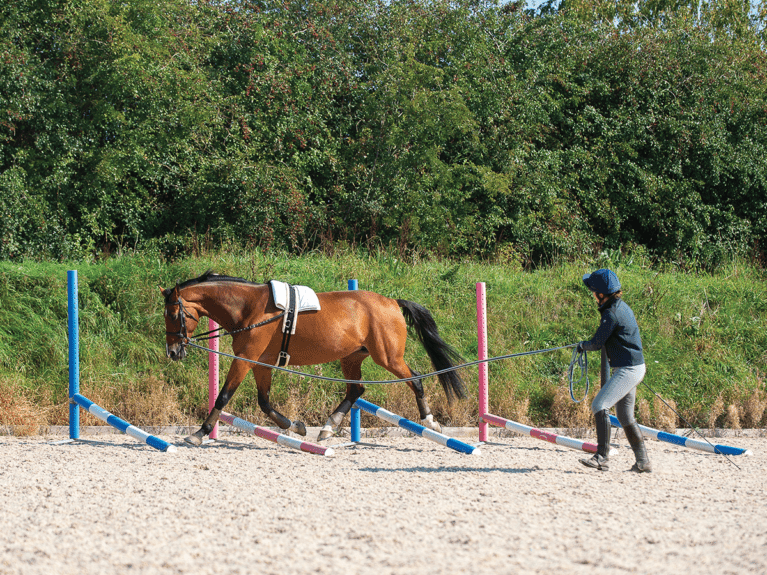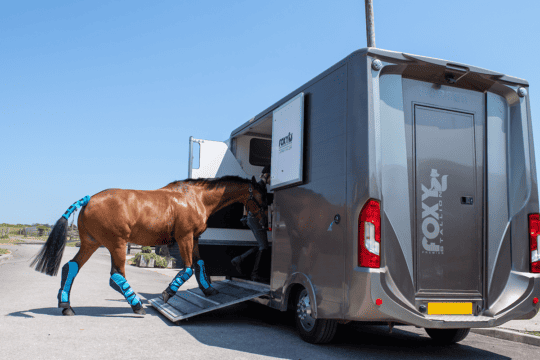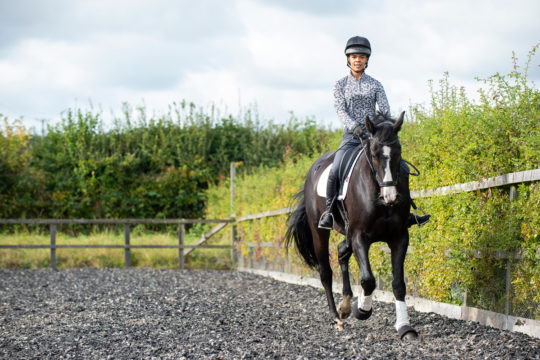Make the most of your lunge sessions by keeping them short, sweet and successful. Fizz Tickridge-Marshall’s exercises will help get you started

One of the biggest challenges that many horse owners face day-to-day is simply finding time to fit everything in. Work plus family life equals a busy day – throw horses into the mix and you can find yourself up against it. As such, getting the most out of your lunge session will put a big tick in the box of working your horse without taking up precious hours in your day. Here’s how to harness the power of lungeing…
Quality over quantity
Including at least one lunge session per week in your horse’s routine not only helps to keep his exercise varied, but also offers you an opportunity to save a bit of time without compromising on the quality or intensity of his workload. Finding a few key exercises that fulfil your objectives will offer structure to the sessions and allow you to target different aspects of his work.
Important factors to take into account are your horse’s current level of fitness and his stage of training. Making his lunge session too hard or easy will mean the quality of work you’re searching for disappears – he’ll either distort his frame if the work’s too tricky or he’ll cruise through your questions without so much as turning a hair and much less breaking a sweat.
TOP TIP
Whatever lungeing aids you choose, keep it simple and ensure they fit with enough room to let your horse carry his face just in front of the vertical, while encouraging him to take the contact forward at all times.
Warm-up wise
Time may be short, but scrimping on a warm-up isn’t the place to make savings. Instead, think about maximising the first few minutes by using them to get him listening and focused. Perform transitions to engage his hindquarters and include changes of rein to make sure both sides of his body are equally limbered up.
Maintaining a balanced canter on the lunge is really hard for some horses, whereas others find it easy. Use his easiest pace to your advantage during the warm-up and you’ll see improvements in the weaker ones later. Play to his strengths and if your horse’s canter is naturally better than his trot, move on to canter once he’s had a stretch. Doing this will help you make gains in his trot, such as more push and power, that you might otherwise struggle to achieve.
Make a plan
When planning your exercises, think about what you’re currently trying to improve under saddle. Hoping to speed up your horse’s response to your leg and develop an injection of power when you ask for it? Or perhaps you need to increase engagement and improve his stability and balance?
TOP TIP
If you know you’re going to be short on time, set up pole exercises the evening before so that they’re ready and waiting when you come to work your horse the next morning.
Exercise one: On-and-back
This exercise asks your horse to open up and collect his strides.
Proper practice
When asking your horse to extend his stride, drop slightly back and position yourself in line with his quarters to drive him forward. Move further into his eye line when asking him to close down his stride for your more collected work, positioning yourself opposite his shoulder.
Beginning in trot or canter…
- Start by finding your horse’s natural working pace. He should be comfortable in his frame with an even tempo and moving forward without appearing rushed. This is the point to which you’ll always return after opening or closing his stride as part of the exercise.
- Ask your horse to slow down, closing his stride and asking him to take shorter, slower steps. Stand still so you’re not urging him forwards with your body language and use your voice to steady him up. This work builds the foundations for collection, so don’t let his energy drop too much.
- Try to get him to maintain this for a few strides before asking him to move back up to working trot. His reaction to your signal should be quick, so be prepared to reinforce your aid with a flick of the whip if he doesn’t respond sharply enough.
- Now that you’ve established the back part of the exercise, try the on element. Using your voice and whip if required, ask your horse to move forward, opening his stride and covering half a circle or so before going back down the gears again. If he just speeds up rather than lengthening, slow him back down and concentrate on getting that initial quick injection of power from his hindquarters, even if he can’t hold it for more than a couple of strides.
- As he gets stronger, mix things up by asking him to go from your slightly collected trot straight up to a more open stride and then back down again, missing the middle stage to test him further.
Exercise two: Raised poles
Set up five or six poles 1.2–1.7m apart. Place a jump wing, block or pole pod on the outside of each.
Proper practice
Straightness through the poles is key to this exercise, so you’ll have to work your lunge circle down the arena until the circle facilitates a clear approach to the poles. Using a smaller circle and a shorter length of lunge line to set him up will help give you more contact and control – he’ll be less able to run out beyond the poles. Should he try to run out towards you, point your whip at his shoulder to encourage him to hold his line.
Stay parallel with your horse’s shoulder as he works through the poles. You’ll need to move quickly to keep up, so be prepared to keep walking with him as you approach the line.
Keeping your horse straight through the exercise is really important. Should he stray a little, use a guide pole before and after your trotting poles, positioned perpendicular to the first and last poles to steer him on the way in and out of the line.
Step-by-step
- If your horse is unfamiliar with polework while lungeing, poles on the ground will be enough for the first session or so. Walk and trot through in both directions, praising him when he gets it right. Polework is physically taxing, and unless he’s reasonably fit, even just a few minutes will be tiring.
- Once he’s trotting through the flat poles comfortably, lift the second and fourth poles but leave the others on the ground.
- Concentrate on keeping him straight through the line and maintaining power rather than speed. This exercise requires engagement, strength and control from your horse so don’t worry if he knocks one or makes a mistake – reset the exercise and praise him when he gets it right.
- Once he’s mastered the two raised poles, lift the third and fifth poles. This will up the intensity of the exercise, so concentrate on preparing your horse by getting the approach right, maintaining the rhythm and encouraging him to keep moving forward if he runs out of steam in the middle of the sequence.
End on a good note
As with any session, always end on a good note and praise your horse’s efforts. The last thing you want to do, particularly when you’re short on time, is get into a battle with your horse. Even if you don’t quite get the level of work you were hoping for, take what he’ll give you and find the positives in what he’s done. Your next opportunity to make further progress won’t be very far away, so take the win when you get it and pick things up again next time











